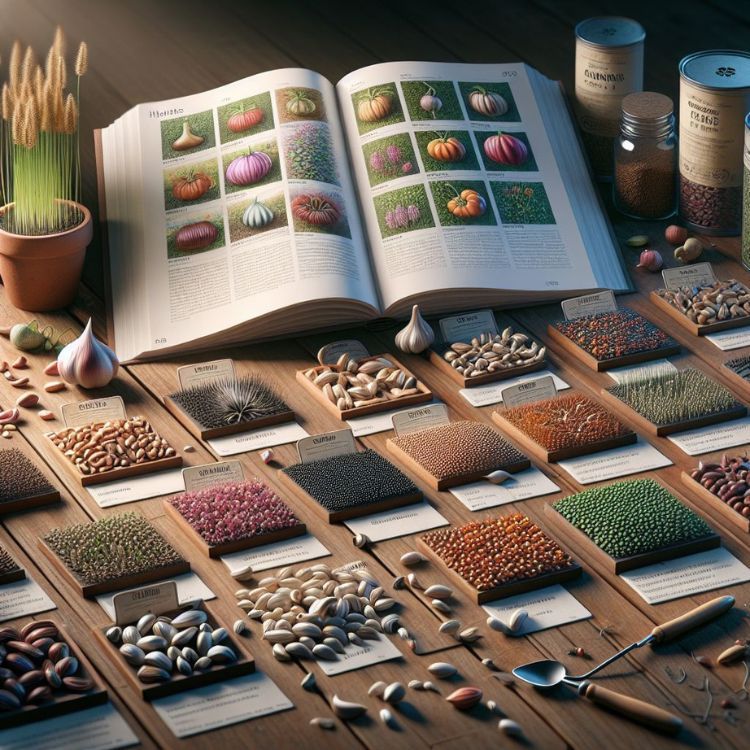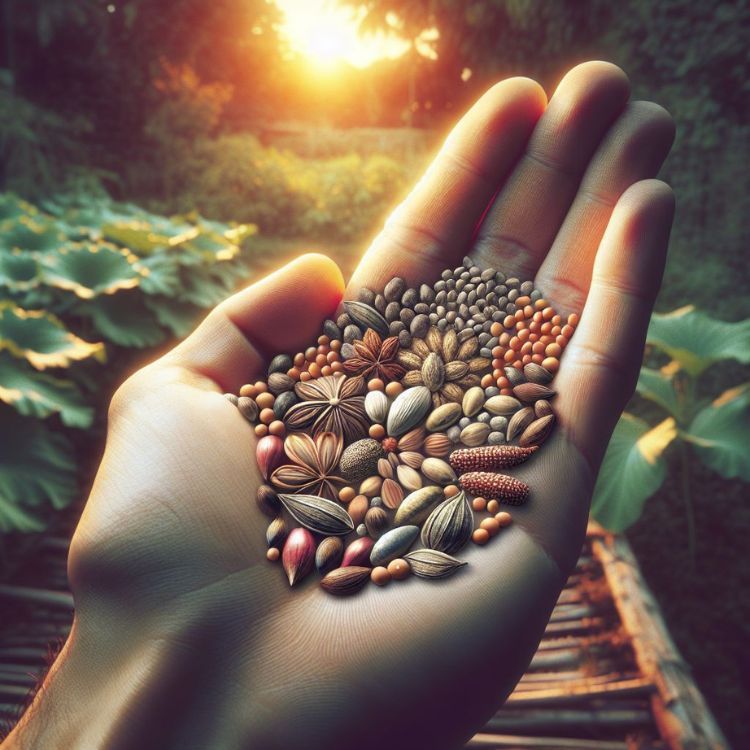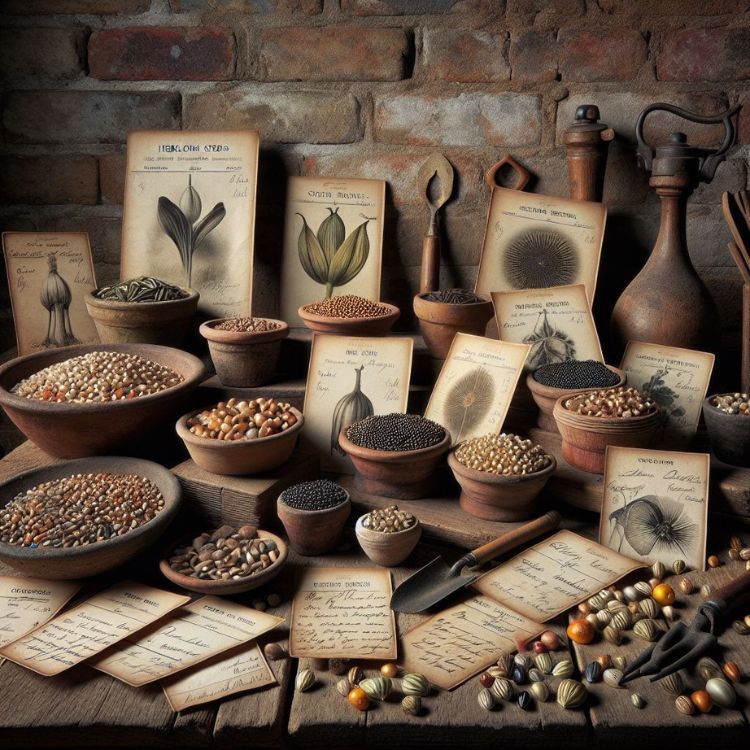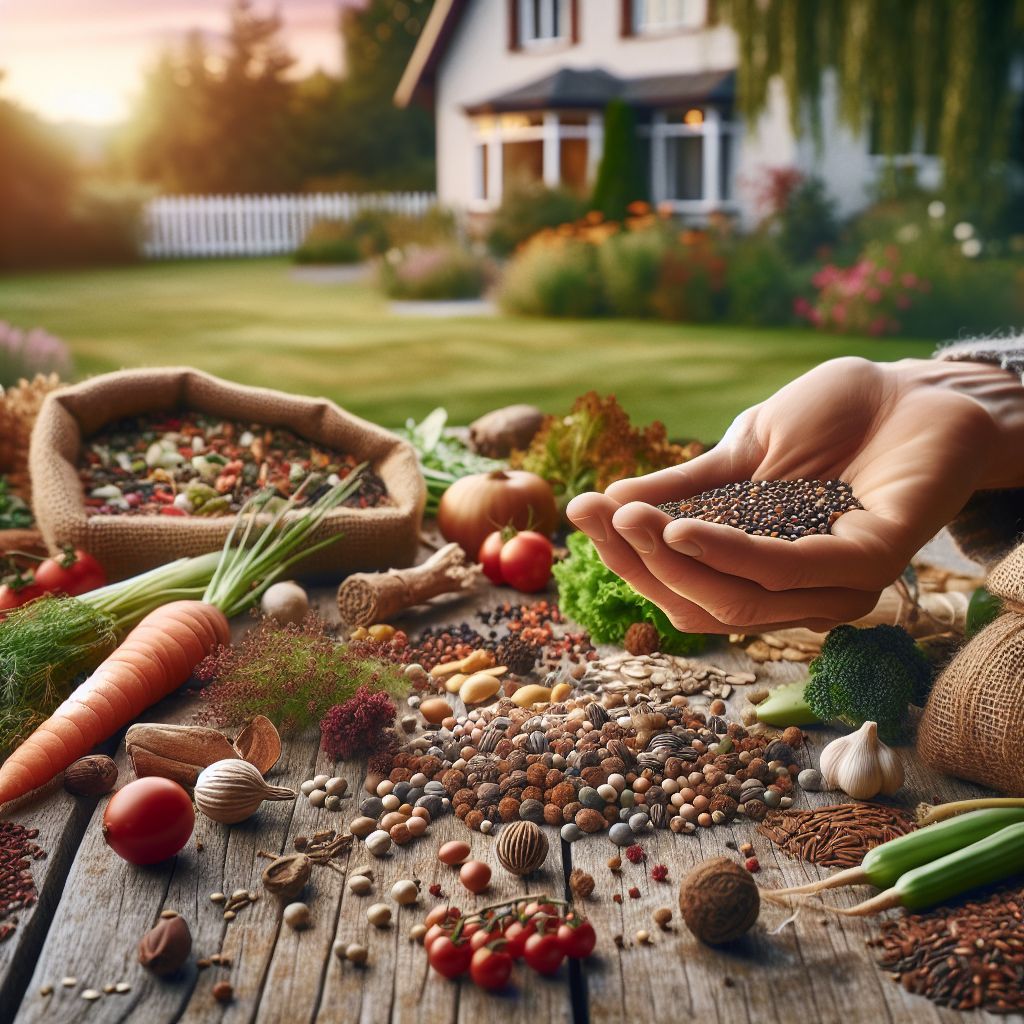
Article-at-a-Glance
- Hybrid seeds are created by crossing two different parent plants for desirable traits.
- Heirloom seeds have been passed down through generations, often over 50 years, and are open-pollinated.
- Open-pollinated seeds are produced by natural means like wind, insects, or birds, and can be saved to grow true-to-type plants.
- Choosing between hybrid, heirloom, and open-pollinated seeds depends on your gardening goals, local conditions, and personal preferences.
- Understanding the differences between seed types is crucial for garden planning and achieving the best harvest.
Seed Selection: The Root of Your Garden’s Success
When you’re gearing up to plant your garden, the seeds you choose are the foundation of your future harvest. It’s like picking a team before a big game – you want the best players to ensure victory. So, let’s get into the nitty-gritty of seed types, and I’ll guide you through picking the champions for your garden.
Distinguishing Seed Genetics
First off, it’s important to know that not all seeds are created equal. There are hybrids, heirlooms, and open-pollinated varieties, each with its own set of characteristics. Understanding the genetic makeup of these seeds is key because it influences how they grow, the care they need, and the bounty they’ll produce.
Balancing Taste, Resilience, and Yield
What’s on your gardening wish list? Is it mouth-watering flavor, a bountiful yield, or plants that stand strong against pests and diseases? Most importantly, you don’t have to choose just one. By understanding seed types, you can have your cake and eat it too – or in this case, grow your tomatoes and savor them as well!
Decoding Hybrid Seeds

Hybrids are like the all-stars of the garden. They’re bred by crossing two different, but related, parent plants to bring out the best traits of both. If you’re after consistency and robustness, hybrids might be your go-to.
- Hybrid seeds often yield more uniform plants.
- They are bred for specific characteristics, such as improved disease resistance.
- Many hybrids are designed to produce a more abundant harvest.
Imagine you’ve got two tomato plants. One is a champion size-wise, and the other never gets sick. Cross them, and you might just get a big, healthy hybrid tomato plant. That’s the magic of hybrid seeds.
What Makes a Seed Hybrid?
Hybrids are the result of a controlled method of pollination, where pollen from one specific plant variety is transferred to the flower of another. This is done to combine the best traits of both plants. Because of this meticulous process, hybrid seeds are often more expensive than open-pollinated or heirloom seeds. But don’t let the price tag fool you; they can be worth their weight in gold come harvest time.
Now, let’s break down what makes hybrids stand out:
- Uniformity: Hybrids grow uniformly, making them ideal for those who appreciate a tidy garden.
- Resilience: They often have built-in resistance to certain pests and diseases.
- Vigor: Hybrids can have more vigor – known as ‘hybrid vigor’ – which can lead to a more abundant crop.
The Perks of Hybrids: Disease Resistance and Uniformity
One of the biggest reasons gardeners choose hybrid seeds is their resistance to disease. This means less worry about your plants wilting from common garden ailments. And because they’re uniform, you’ll know what to expect in terms of plant size and fruit production, which can make planning your garden layout a breeze.
Let’s consider an example: the ‘Early Girl’ tomato is a hybrid known for its early ripening and consistent, round fruits. It’s like clockwork in the garden, offering predictability along with its juicy rewards.
Limits of Hybrids: Why Saving Seeds Might Not Work
However, it’s not all sunshine and rainbows with hybrids. Saving seeds from hybrid plants often leads to a surprise mix in the next generation. This is because the offspring may not retain the desired traits of the hybrid parent. So, if you’re looking to save and replant seeds each year, hybrids might not be your best bet.
Consider this: if you save seeds from that ‘Early Girl’ tomato, the next crop might not be the punctual producer you’re used to. You could end up with a variety of shapes, sizes, and ripening times. It’s a bit like a box of chocolates – you never know what you’re gonna get. For those interested in edible parts of vegetables and how to make the most of your produce, understanding seed variety is crucial.
Heirloom Seeds: Relics of Horticultural Heritage

Heirloom seeds are the storytellers of the garden world. They’ve been handed down through generations, often for more than 50 years, and are open-pollinated, which means they’ve been naturally pollinated by wind, insects, or birds. These seeds can be saved and grown year after year, producing plants true to the parent’s form.
Here’s why heirlooms are cherished:
- Flavor: Many gardeners swear by the superior taste of heirloom vegetables.
- Diversity: Heirlooms come in an astonishing variety of shapes, sizes, and colors.
- Heritage: Growing heirlooms connects you to gardening traditions of the past.
If you’re looking for a tomato with a story, you might pick the ‘Brandywine’ variety. It’s an heirloom with a reputation for outstanding flavor and a fascinating history that traces back to the 1800s.
In the next part of this article, we’ll delve deeper into the world of heirloom seeds, explore the advantages of open-pollinated varieties, and help you decide which seeds will help your garden thrive. And remember, whether you’re a seasoned gardener or just starting out, choosing the right seeds is the first step to a bountiful and beautiful garden.
Heirloom Allure: Flavor and Diversity
Heirloom seeds are like the cherished recipes passed down in a family, each with a story and a legacy of its own. They’re treasured not only for their rich history but also for their exceptional flavors. Think of them as the ‘gourmet’ option in the seed world, offering a taste that’s often more complex and nuanced than what you might find in their hybrid counterparts.
It’s not just about the taste, though. Heirlooms offer a rainbow of colors and a variety of shapes that can turn your garden into a vibrant tapestry. They’re the perfect choice for gardeners who value aesthetic beauty and culinary delight in their harvest.
- Unmatched flavor profiles that can elevate your cooking.
- An incredible array of colors and forms that add beauty to your garden.
- A connection to the past, with each variety having its own unique story.
Picture slicing into a ‘Green Zebra’ tomato, its striking green and yellow stripes making a bold statement on your plate, or the deep, earthy taste of an ‘Amish Paste’ tomato in your homemade sauces. These experiences are what make heirlooms so special.
Challenges with Heirlooms: Sensitivity and Yield Consistency
While heirlooms have undeniable appeal, they also come with their own set of challenges. They can be more sensitive to environmental stresses and are often less disease-resistant than hybrids. This means they might need a bit more TLC to thrive in your garden.
Yield consistency is another factor to consider. Heirlooms may not produce as predictably as hybrids, which can be a concern if you’re counting on a certain amount of produce. But for many gardeners, the trade-offs are well worth it for the exceptional taste and the joy of preserving biodiversity.
Open-Pollinated Varieties: Natural Selection at Work
Open-pollinated seeds are the workhorses of the seed world. They’re reliable, resilient, and ready to reproduce true to type. These seeds are pollinated by natural mechanisms like bees, butterflies, or even the wind, resulting in offspring that are a close genetic match to their parents.
What’s remarkable about open-pollinated varieties is their adaptability. As they’re exposed to the local environment over several generations, they gradually become more attuned to the specific conditions of your garden. This means they can become more resistant to local pests and diseases and better adapted to your soil and climate.
For the gardener looking to create a sustainable and self-reliant garden, open-pollinated seeds are a gold mine. They allow you to save and share seeds with confidence, knowing that the plants they produce will be just as vigorous and true-to-type as the ones before them.
- Ability to save seeds that will grow true to the parent plant.
- Increased adaptability to local growing conditions over time.
- Supports biodiversity and the preservation of unique varieties.
Open-Pollinated Versus Controlled Pollination
Open-pollinated plants are the product of a natural dance between plants and their pollinators. Unlike hybrids, there’s no controlled cross-pollination here. This freedom allows for genetic diversity within a plant population, which can lead to exciting and unexpected variations in your garden.
Advantages of Going Open-Pollinated
Choosing open-pollinated seeds is like investing in the future of your garden. They’re generally more affordable and offer the ability to adapt over time, which can be especially valuable in the face of changing climate conditions.
Here’s why you might choose open-pollinated seeds:
- They often cost less than hybrids and heirlooms, making them a budget-friendly option.
- You can save seeds from year to year, reducing your need to purchase new seeds annually.
- They contribute to genetic diversity, which can help create a more resilient garden ecosystem.
For example, if you grow open-pollinated ‘Dragon’s Tongue’ beans, you can expect the same striking purple-streaked pods and delicious flavor year after year, as long as you save your seeds.
Considering Variability and Adaptation
With open-pollinated seeds, you’ll need to embrace some variability. Your plants might not be as uniform as hybrids, but that’s part of the charm. This genetic diversity can be a strength, allowing plants to better cope with local growing conditions and pests.
- Expect some variation in plant size, shape, and productivity.
- Embrace the uniqueness of each plant as a natural expression of genetic diversity.
- Over time, select and save seeds from the best-performing plants to enhance desired traits in your garden.
As you become more experienced, you’ll start to notice which plants are thriving and which ones are struggling. Save seeds from the winners, and you’ll be on your way to developing a strain that’s custom-tailored to your garden’s microclimate.
Remember, gardening is a journey, and every season brings new lessons. Whether you choose hybrids for their vigor, heirlooms for their legacy, or open-pollinated varieties for their adaptability, you’re nurturing more than plants – you’re cultivating a connection to the earth and a sense of place in the world.
Choosing What’s Best for Your Garden

Now, with all this knowledge at your fingertips, how do you decide which seeds to plant? Think about what matters most to you. Is it the reliability and uniformity of hybrids, the rich history and flavor of heirlooms, or the adaptability and sustainability of open-pollinated varieties?
Your garden is a reflection of your values and your vision. So choose seeds that resonate with your gardening philosophy and that will thrive in your unique growing conditions.
Assessing Your Gardening Goals and Conditions
Before you dive into seed catalogs or stroll down the garden center aisles, take a moment to consider your goals. Are you looking to maximize your yield, or is the diversity of flavors and colors more important? Do you have the time to provide extra care for sensitive heirlooms, or do you need the hardiness of hybrids?
Your local climate and soil type are also crucial factors. Some varieties will naturally do better in your region than others. And don’t forget about your personal taste – after all, you’ll be the one enjoying the fruits of your labor!
Local Climate and Soil: Deciding Factors in Seed Selection
Your local environment is a big player in the garden game. Heirloom tomatoes that flourish in a friend’s garden on the coast might not do as well in your drier, inland climate. Similarly, a hybrid squash that’s resistant to powdery mildew might be a lifesaver in a more humid region. Because of this, it’s smart to choose seeds adapted or bred for your specific conditions.
Here’s a tip: Check with your local extension office or gardening clubs for advice on what grows best in your area. They can be a goldmine of information, helping you to avoid costly mistakes and disappointing harvests.
Your Personal Touch: Culinary Preferences and Aesthetic Choices
Let’s not forget the personal joy of gardening. Maybe you’re dreaming of a salsa garden with every color of tomato, or perhaps you’re after the sweetest peas to eat straight off the vine. Your garden should be a source of pride and pleasure, so choose seeds that excite you and fit your culinary aspirations.
And if beauty is what you’re after, heirloom flowers like ‘Grandma’s Cut’ zinnias or the starry blooms of ‘Love in a Mist’ can transform your garden into a living painting, one that you’ve brushed with your own hand.
Frequently Asked Questions
Can hybrid seeds become heirlooms over time?
No, hybrid seeds cannot become heirlooms over time. Heirlooms are varieties that have been stabilized and passed down for many generations. Hybrids, on the other hand, are the first generation of a cross and their seeds do not breed true, meaning they will not reliably produce plants with the same traits as the parent.
Why might a gardener prefer heirloom seeds over hybrids?
A gardener might prefer heirloom seeds for several reasons:
- They often offer more complex flavors, which can be a delight for the taste buds.
- Heirlooms help preserve genetic diversity and agricultural history.
- They allow gardeners to save their own seeds, which can be both rewarding and cost-effective.
Are all non-hybrid seeds considered heirlooms?
Not all non-hybrid seeds are considered heirlooms. For a seed to be an heirloom, it generally needs to have a history of being passed down within a family or community and be at least 50 years old. Non-hybrid seeds that don’t meet these criteria are simply open-pollinated seeds.
How can I tell if a seed is open-pollinated?
You can tell if a seed is open-pollinated if it is labeled as such, or if you know the variety has been stabilized and can produce offspring that are true to type. Open-pollinated seeds are pollinated by natural means and are not the result of a controlled cross like hybrids.
What are the legal implications of using patented hybrid seeds?
When it comes to patented hybrid seeds, there are legal restrictions:
- You are not allowed to save and replant seeds from patented hybrids, as this would violate the patent holder’s rights.
- Always read and follow the seed packet’s licensing agreement to avoid any legal issues.
- If in doubt, purchase new seeds each season to comply with patent laws.
As you peruse the array of seed packets, each promising a bounty of produce and beauty, keep in mind the valuable insights we’ve discussed. Whether you’re drawn to the uniformity and disease resistance of hybrids, the rich flavors and historical significance of heirlooms, or the adaptability and resilience of open-pollinated varieties, your garden is an expression of your creativity and dedication.
For those embarking on their seed journey and seeking a reliable source, consider Survival Essentials. Here, you’ll discover a diverse selection of heirloom seeds tailored to meet the needs of every gardener. Embrace the excitement of planting, the anticipation of growth, and the fulfillment of harvest. Your gardening adventure awaits!
Remember, each type of seed has its unique role in the garden. It’s not about identifying the “best” seed; it’s about identifying the best seed for you. Happy gardening!






